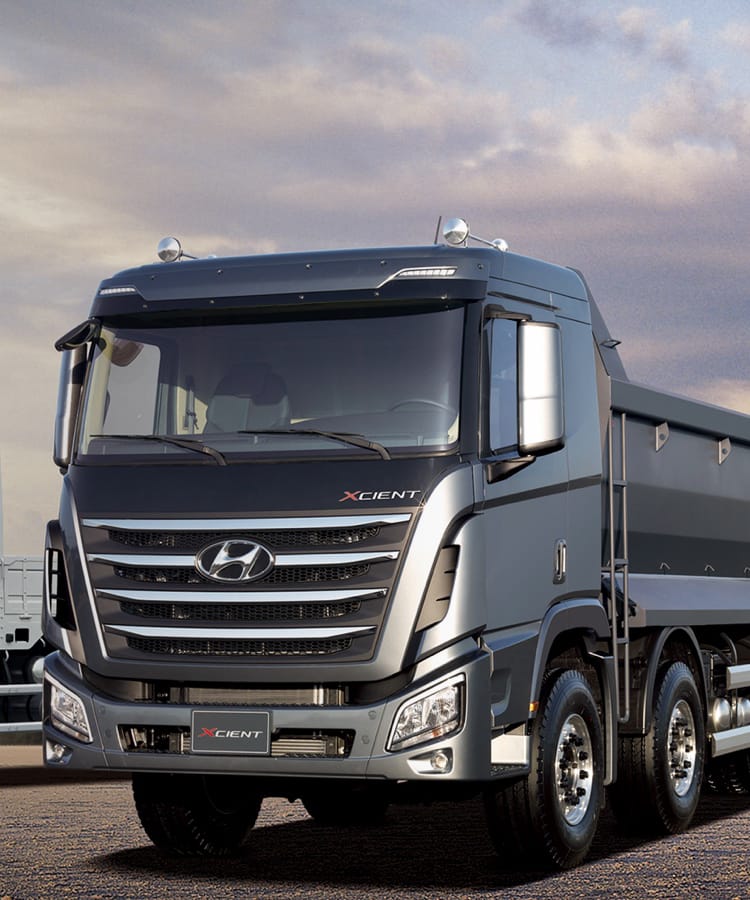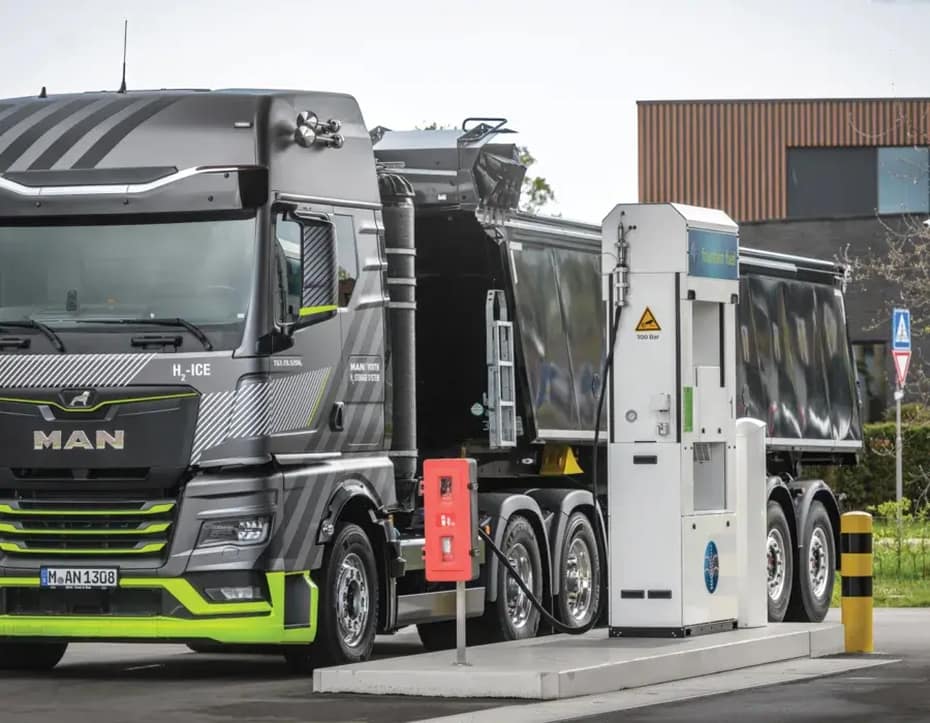Hydrogen is arriving in heavy goods transport through three practical routes—fuel-cell electric trucks and buses, hydrogen internal combustion engines (H2ICE), and dual-fuel conversions—and each suits different operational realities. For fleet owners, the key is timing: dual-fuel is deployable now; fuel-cell vehicles are entering targeted commercial operations; and hydrogen combustion will appeal to operators who value familiar engines as production ramps later this decade. The evolution of hydrogen heavy goods transport is pivotal for future logistics.
Element 2 is building the UK’s first national hydrogen refuelling network, using mobile stations while permanent sites are consented. Economics remain duty-cycle-specific—total cost of ownership (TCO) depends on utilisation, fuel price, and customer procurement pressure rewarding low-carbon delivery.
Fuel-Cell (FCEV)Electric Vehicles for Hydrogen Heavy Goods Transport
Fuel-cell electric vehicles are the most mature zero-emission option for long-haul duty cycles requiring rapid refuelling and full payload. Hydrogen is converted to electricity via a fuel cell to drive an e-axle, giving diesel-like range with refuelling times in minutes. Analysts such as Roland Berger forecast near-diesel TCO parity before 2030 at about €4/kg hydrogen for high-utilisation fleets.
That logic explains why fuel-cell buses have led UK adoption: predictable routes, depot refuelling, and public-sector procurement matured maintenance and fuel logistics. The technology is now crossing to freight. Hyundai’s XCIENT Fuel Cell trucks are operating in early commercial deployments across Europe, supported by OEM alliances under the H2Accelerate consortium, which includes Daimler Truck, Volvo Trucks, and IVECO. Together, these manufacturers are preparing for scaled deployments later this decade, combining vehicle production with coordinated refuelling infrastructure expansion.
Hydrogen Internal Combustion Engines (H2ICE)
Hydrogen internal combustion engines take a different route by adapting proven diesel architectures to run on hydrogen. They preserve drivelines, gearboxes, and servicing familiarity—reducing organisational disruption. Cummins is developing 6.7 L and 15 L hydrogen engines for heavy-duty use, targeting model-year 2030. In construction and off-highway, JCB has secured approvals across multiple European countries and is moving toward series production; that engineering base will migrate into on-road HGVs as standards align.
While H2ICE sacrifices some efficiency versus fuel cells, it offers lower capital cost and workshop continuity. For deeper technical coverage see Hydrogen Internal Combustion Engine Guide.
Dual-Fuel Hydrogen–Diesel Conversions
Dual-fuel hydrogen conversions are the pragmatic on-ramp for risk-averse fleets. They allow an existing diesel HGV to displace 30–50 % of fuel with hydrogen while retaining diesel-only operation if needed. ULEMCo has pioneered these systems, partnering with Luxfer Cylinders for high-pressure storage. Conversions cut CO₂ immediately and build operational know-how without waiting for new-vehicle lead times.
From Pilot to Programmatic Deployment
Hydrogen availability is shifting from pilot to scalable rollout. Dual-fuel conversions can be ordered today; fuel-cell buses are mainstreaming across UK authorities; and heavy trucks will scale through 2026–2028 as OEMs expand production and financing frameworks mature. Hydrogen combustion will follow off-highway’s trajectory: early niches, then broader uptake late in the decade. The decisive constraint is still fuel supply.
Infrastructure: The Real Bottleneck
Infrastructure determines whether hydrogen projects succeed. The UK’s legacy public network is sparse, but Element 2 is accelerating a national build-out—its “50 in 5” plan combines mobile refuelling units and permanent sites. Early corridors such as Glasgow’s, developed with Russell Logistics, show how mobile stations enable live operation ahead of fixed sites. Permanent HGV-scale hubs at Coneygarth and Golden Fleece and partnerships with Exelby Services expand coverage on strategic routes.
Depot-based refuelling remains most economical for large operators, with turnkey hydrogen supply and compression systems available under long-term offtake agreements. Smaller fleets can share hubs to lift utilisation and reduce fuel cost per kg.
Total Cost of Ownership (TCO)
TCO decides board approvals. Fuel-cell trucks still have the highest capital cost but can reach competitive running costs with €4/kg hydrogen and high utilisation. Hydrogen combustion narrows the capital gap and preserves service economics, though efficiency is lower. Dual-fuel conversions have minimal upfront cost and hedge fuel risk. “Soft” cost factors—zero-emission-zone access, carbon pricing, and customer procurement policies—are increasingly decisive.
Customer & Policy Pressure
Customer demand is now a measurable driver. Large retailers and manufacturers expect logistics partners to disclose and cut emissions. Fleet tenders increasingly require evidence of credible zero-emission plans. Policy is aligning: UK regulations will phase in zero-emission HGV sales shares in the 2030s, tightening the economics for diesel through taxes and road-user charging.
When Should Fleets Act?
The answer: now. Conduct route and depot analysis to find hydrogen-suitable duty cycles—daily distances > 200 km, predictable schedules, or grid-charging constraints. Engage partners early for site assessments and mobile refuelling. Pilot a dual-fuel conversion or small fuel-cell fleet; train drivers and technicians on hydrogen safety; and align procurement cycles so replacements from 2027 onward include hydrogen options.
Building a Phased Hydrogen Plan
A realistic phased plan begins with a pilot that proves duty cycle, fuelling, and maintenance. Scale to a second route while transitioning from mobile to permanent infrastructure. Match technology to task: dual-fuel where flexibility matters; fuel cells on backbone routes with guaranteed supply; and hydrogen combustion for rugged or service-critical roles. Early movers will secure fuel and infrastructure ahead of demand.
Next Steps for Fleet Operators
For immediate action, dual-fuel conversions via ULEMCo remain the fastest route to begin cutting emissions with hydrogen. For medium-term rollout (2026–2028), fleets should engage established OEMs now advancing credible hydrogen truck programmes.
- Fuel-cell trucks: Hyundai’s XCIENT Fuel Cell continues commercial operation in Europe, while Daimler Truck, IVECO, and Volvo Group are collaborating through the H2Accelerate programme to deploy up to 150 heavy-duty fuel-cell vehicles and refuelling corridors across Europe by 2029.
- Hydrogen combustion trucks: Volvo Trucks is testing hydrogen combustion engines for late-decade production, complementing R&D from Cummins and off-highway pioneer JCB.
Build your refuelling roadmap with Element 2, which can provide mobile hydrogen stations for pilot projects and transition fleets to fixed sites as utilisation grows. For most operators, the essential next step is engaging infrastructure partners—because fuel availability, not spec sheets, is what ultimately unlocks scale.

